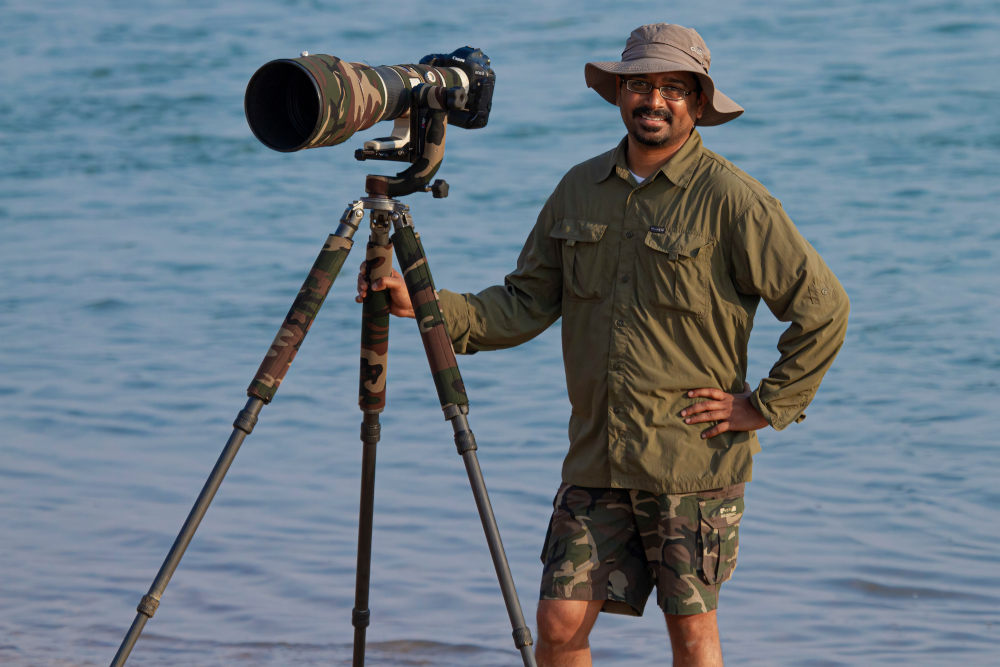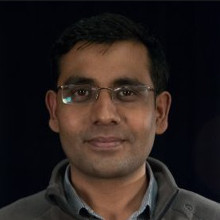[Photo by Vasanth Asokan]
Some weekends ask us to slow down—not for leisure, but for clarity. This is one of them.
We return to the forests, water bodies, and grasslands that Ramakrishnan “Ramki” Sreenivasan cared for so deeply. Ramki was a widely admired voice in India’s wildlife conservation movement, a passionate photographer, a mentor to many, and a long-time contributor to Founding Fuel. He was also the brother of our co-founder CS Swaminathan (Swami) and a cherished member of the Founding Fuel family. Ramki was an SPJIMR alum (Class of 1995), honoured posthumously with the institute’s Social Excellence Award in 2023.
Through his writing, conversations, and tireless advocacy, he reminded us that wildlife photography is not merely about good images—it is about responsibility, restraint, and humility in the presence of another living being.
He championed ethical photography long before it became a mainstream conversation. He refused to disturb nests, bait animals, or pursue the rising “trophy shot” culture. Friends recall how he nudged photographers to think beyond composition: What impact does my presence have? What will this moment cost the animal?
After he passed away in December 2022, his family, together with the Nature inFocus community he helped shape, instituted an award in his name—one devoted to conservation photography. Nature inFocus is a popular platform for photo-led exploration of nature and wilderness. The Ramki Sreenivasan Conservation Photography Award—a dedicated category within the Nature inFocus Photography Contest—encourages photographers to document uncomfortable truths. Not beauty alone. Not a spectacle. But photographs that expose our impact on the natural world, provoke discomfort, stir empathy, and plant the seed of action.
Swarna Venkataraman, Ramki’s wife and a member of this year’s jury, says the idea behind the award felt “almost inevitable”. The festival had long showcased stunning, almost otherworldly images of wildlife. But beauty, she says, is only half the story—and sometimes, the safer half.
“Whenever we speak of beauty in the natural world, destruction is never far away—often just outside the frame. In beauty also lies responsibility. And in beauty lies the possibility of loss,” she says.
For Swarna, the conservation category fills a crucial gap: it makes the unseen visible. “Wildlife photography has always been associated with the ‘wow’ image. But how do we begin talking about what it costs us—and costs the animals—when we lose a habitat, a river, a species? This category forces us to have those conversations.” It felt only right, she adds, that this space—this insistence on going beyond the “pretty picture”—carries Ramki’s name. “He started as a wildlife photographer but became a conservation photographer. His work was full of the ‘gory scenes’: snaring, hunting, feral dogs, oil spills, the Amur Falcon massacre. Things people didn’t want to look at, but had to.”
Inside the Jury Room
Swarna and the founders of Nature inFocus, Kalyan Verma and Rohit Verma, were on the jury. They reviewed every category—thousands of images eventually distilled into a sharply focused shortlist. The second round demanded slow, deliberate looking. “We didn’t know who the photographers were. All we saw were the images and the captions,” Swarna says. Each of the six jury members voted, debated, and returned again to images that split the room.
What struck her most was the breadth of issues this year’s entries captured. Some were familiar—plastic in national parks, ungulates foraging in garbage dumps. But the jury also sought images that pushed the boundaries of storytelling.
“We wanted to highlight issues people don’t usually think of as conservation concerns,” she says. “For example, the immersion of idols into lakes. We’ve all grown up seeing it; no one calls it a wildlife problem. But it is. We’re knowingly and purposefully polluting the water that sustains marine life."
The same applied to images inside zoos. “Similarly, zoos are rarely framed as a conservation problem. For Ramki especially, what mattered was the integrity of free-ranging species. So we wanted to include images that challenged assumptions, that made us ask harder questions.” She was also quietly thrilled to see several women among the winners and special mentions. “It was wonderful to see more women telling these stories—showing the world that yes, there is beauty, but if we don’t protect it, this is what happens.”
What the jury saw in this year’s entries echoed what conservationists have been warning us about: a quiet but alarming shift in how wildlife is being forced to live alongside us.
A dire picture
What this year’s entries revealed—and what conservationists have been tracking for years—is a pattern that is both startling and deeply sobering. Across India, species are adapting in ways that speak less to resilience and more to desperation:
- Monkeys in towns and hill stations “addicted” to carb-heavy snacks, growing obese and losing the ability to forage or survive in the wild.
- Leopards adjust to human-dominated landscapes by hunting dogs, scavenging on city fringes, and venturing ever closer to traffic corridors.
- Elephants return to high-calorie crops such as sugarcane, jackfruit, and paddy because they offer easier calories than increasingly scarce wild forage.
- Frogs, birds, and small mammals breeding or nesting in construction sites, depots, and storm drains that mimic the habitats they have already lost.
- Rituals like idol immersions subtly altering lakes and reshaping the behaviour and survival of aquatic species.
The photographs in this slideshow—the winning images from this year’s competition—capture these realities without embellishment. They sit at the shifting edge where humans and wildlife now coexist in uneasy proximity: a leopard feeding on a carcass beside traffic, an elephant limping through a landfill, frogs calling for mates in half-built bus depots, a fishing cat staring back from a shoreline smothered in plastic.
Each frame is a reminder that these are not isolated moments. They are signals. And they are telling a story we can no longer ignore.
Taken together, these moments form a mosaic of a world under stress.
Why these images matter
In the end, the award is not only a tribute to Ramki’s memory. It is an invitation—to photographers, to storytellers, to citizens—to see the world more honestly.
“Beauty is important,” Swarna says, “but beauty without awareness is dangerous. These photographs show us what is real—not just what we stand to lose, but what we have already begun to lose.”
Each photograph is a fragment of a larger narrative—of shrinking habitats, of animals adapting to our carb-rich waste, of human rituals altering ecosystems, and of the ethical dilemmas that define modern wildlife photography. They invite us to look, to reckon, and perhaps to choose differently.
[On a mobile screen, best viewed in landscape mode]
What’s Planned Next: Bird Walk + Memorial Lecture
Access: Open to all teams interested in birdwatching and observation.
Register here: https://birdcount2025.paperform.co/
2nd Annual Hesaraghatta Bird Count
Date: 21 December (Sunday)
Time: 7:00 AM to 10:00 AM
Location: Greater Hesaraghatta Conservation Reserve, Bengaluru
What’s Happening:
- Led by volunteers from BngBirds, teams of birders will conduct a coordinated bird count from designated points across the Reserve.
- Observations will be logged on the eBird app.
- The data will be compiled to build a record of species found in the newly notified Reserve and track population patterns over the years.
Ramki Sreenivasan Memorial Talk & Lunch
Venue: Our Native Village Eco Resort, Hesaraghatta
When: After the Bird Count
Session highlight: A panel discussion with the birdwatchers who rediscovered the Jerdon’s Courser after nearly two decades, and outside its last known range. Their acoustic rediscovery offers fresh scientific insight and renewed hope for conservation of this critically endangered species.
Register here: https://birdcount2025.paperform.co/
Dig Deeper
If this story resonates, here are some pieces that illuminate Ramki’s passions and the broader themes of conservation:
• A Beginner’s Guide to Birdwatching — from our archives
Ramki’s gentle introduction to the joys of birding—and how to turn it into a lifelong practice.
• Seven Resources to Understand Climate Change
A curated list from Conservation India (CI), the platform Ramki co-founded, offering science-based ways to understand and respond to climate change.
• Killing a Grassland
Ramki’s searing post and images that chronicle the destruction of the Hesaraghatta grasslands—and the hard-won progress toward declaring it the Greater Hesaraghatta Conservation Reserve.
• From catastrophic to the sustainable: the flight of the Amur Falcon
An interview with Shashank Dalvi and Ramki on their work to help save the Amur Falcon of Eurasia.
• Leopards in Sugarcane Fields
A report on how leopards in Uttar Pradesh are adapting to high-calorie crops, growing softer and fatter—and what that means for their future in the wild.
• Novel Foraging Skills in Monkeys (Video)
A short explainer on how monkeys in human-dominated landscapes evolve new feeding behaviours that reshape their survival strategies.



